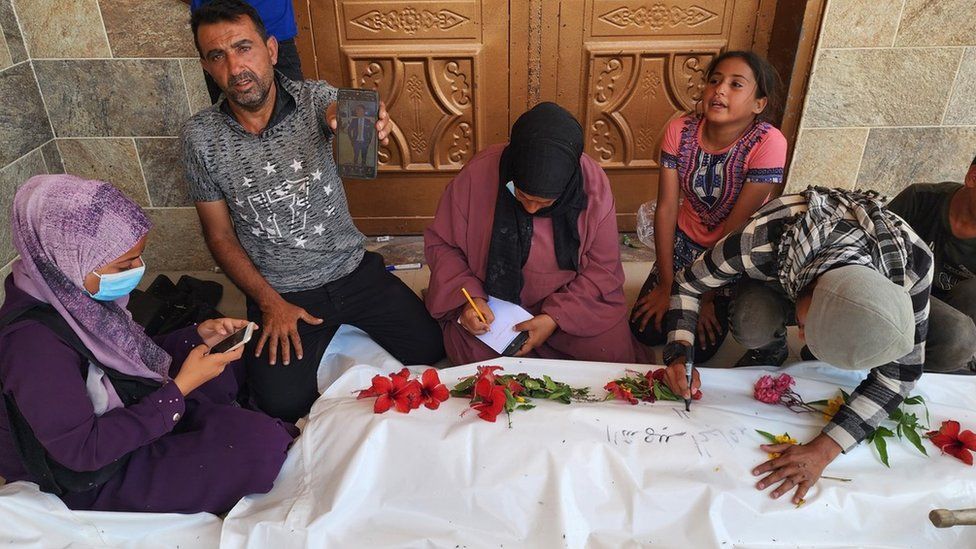Searching for missing loved ones in Gaza’s mass graves
-
Published

A mother will search anywhere for her missing child. And while she has the strength, she will never stop.
Whether he is alive or dead. It doesn’t matter.
For four days Kareema Elras has moved through the noise, dust and overpowering stench of the mass graves at Nasser hospital.
She is the mother of 21-year-old Ahmed, who was killed on 25 January in the city of Khan Younis, in south central Gaza. His body has been missing since then.
On Tuesday, Kareema found her boy.
“I have been coming here all the time until now,” she said, “until I found the body of my son, my son Ahmed, the cherished little boy, his mother’s love. He lost his father when he was 12 years old, and I raised him.”
Nearby, other families walk along the perimeter of the graves.
It is a scene depressingly familiar from war zones around the world.
The bulldozers clawing at the earth to reach the dead. An arm, stiff, extending from beneath the soil. The gravediggers marking out the individual spaces where exhumed corpses will be buried. And the families of the lost, hoping to find their loved ones among the dead.
But the universality of the imagery does not necessarily suggest the same explanation. Each mass grave – whether in the Balkans, central Africa, the Middle East, or elsewhere – is the consequence of its own local conditions.
In a war that has reportedly claimed the lives of more than 34,000 people in a constricted land space, burying the dead has become a complex and often dangerous task.
Some cemeteries are full. Others are impossible to reach because of fighting. Because of these pressures bodies have been buried in the grounds of hospitals where Israeli forces said they fought Hamas.
In some wars that I have reported on it was possible to tell reasonably quickly what had happened to the victims. This is because forensic investigators were on the scene relatively soon afterwards and journalists were able to access the area.
In the current conditions in Gaza – with Israel and Egypt refusing to admit international journalists, and fighting creating extremely dangerous conditions for any potential team of forensic investigators – it is an immense challenge to specifically determine how and when each of those being exhumed from the graves at Nasser hospital and also at al-Shifa hospital, to the north in Gaza City, met their deaths.
Were at least some executed by Israeli forces, as Hamas and local rescue workers claim?
Or are the hundreds of dead in mass graves all the victims of air strikes and fighting in the area inside and around the medical complexes, as well as other victims of disease and malnutrition caused by the war? Did the Israelis move bodies from one grave to a new grave?
BBC Verify authenticates video from key moments in the story of Nasser Medical Complex in Gaza
The director of the United Nations High Commissioner for Human Rights office for the Palestinian territories, Ajith Sunghay, told me there had to be an independent forensic investigation of the graves.
On Tuesday, another UN official said that some bodies had been found with their hands tied.
This followed a statement by an official of the Palestinian Civil Defence, a group which carries out rescue and recovery operations, that corpses had been found handcuffed, that others had been seen shot in the head, and some wearing detainee uniforms.
I asked Mr Sunghay if he had evidence to back claims that some bodies had been found with their hands tied.
“We still don’t have evidence, we have information,” he replied. “And that information needs to be corroborated from different sources. And that’s exactly why we do need an independent international investigation.”
“What we cannot allow, in this current situation where we have seen in Gaza numerous grave human rights violations, many of them potentially war crimes, and where we have raised alarm of potential atrocity crimes, that this becomes another blip. The intensity of violations has been massive.”
Mr Sunghay said he had teams ready to deploy in Gaza if they were given permission and safe passage by Israel.
The Israeli side has dismissed as a libel the claim that it buried bodies at the hospitals.
In a statement, the Israel Defense Forces said: “The claim that the IDF buried Palestinian bodies is baseless and unfounded.”
The IDF added that bodies were exhumed and checked to see if any were those of hostages seized by Hamas and taken to Gaza during the 7 October attacks on Israel.
The statement said: “The examination was conducted in a careful manner and exclusively in places where intelligence indicated the possible presence of hostages. The examination was carried out respectfully while maintaining the dignity of the deceased.”
The work of trying to identify and give a decent burial to the dead will continue for days to come.
Somaya al-Shourbagy retrieved her husband Osama’s body at Nasser hospital and managed to bring him to a cemetery to be laid to rest next to the rest of their family.
She knelt by the freshly dug grave with the couple’s daughter, Hind.
“My young daughter asked me to visit the grave of her father,” Somaya said, “and I would tell her that as soon as we bury him, we will visit him. Thank God. The situation is tough, but we might find some relief after burying him.”
Little Hind, who is around five years of age, remembered her father through the clear, simple eyes of a child: “He loved me, and used to buy things for me, and he used to take me out.”
With additional reporting by Alice Doyard, Haneen Abdeen and Nik Millard
Related Topics
-
-
Published4 hours ago
-
-
-
Published16 hours ago
-
-
-
Published2 days ago
-







